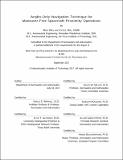| dc.contributor.advisor | David W. Miller, Sheila E. Widnall, Sumanth Kaushik, Kyle T. Alfriend and Alvar Saenz-Othro. | en_US |
| dc.contributor.author | Yates, Max William, Major | en_US |
| dc.contributor.other | Massachusetts Institute of Technology. Department of Aeronautics and Astronautics. | en_US |
| dc.date.accessioned | 2018-02-16T19:27:02Z | |
| dc.date.available | 2018-02-16T19:27:02Z | |
| dc.date.copyright | 2017 | en_US |
| dc.date.issued | 2017 | en_US |
| dc.identifier.uri | http://hdl.handle.net/1721.1/113719 | |
| dc.description | Thesis: Ph. D., Massachusetts Institute of Technology, Department of Aeronautics and Astronautics, 2017. | en_US |
| dc.description | This electronic version was submitted by the student author. The certified thesis is available in the Institute Archives and Special Collections. | en_US |
| dc.description | Cataloged from student-submitted PDF version of thesis. Vita. | en_US |
| dc.description | Includes bibliographical references (pages 242-256). | en_US |
| dc.description.abstract | The technique of angles-only navigation consists of a single surveyor making line-of-sight observations of a target to deduce a relative navigation state from a sequence of angle measurements. Historically, angles-only navigation has been impeded by a range ambiguity problem in its many applications, especially those involving linear dynamical models. A classical solution to the problem is for the surveyor to perform precise maneuvers to change the nominal angle profile between the surveyor and the target. In the space environment, the orbital dynamics are inherently nonlinear and natural orbit perturbations have the effect of continuous micro-maneuvers. These advantageous conditions present an opportunity to overcome the ambiguity problem and enable spacecraft to navigate passively with a lightweight, low-power camera without the associated fuel cost of maneuver-assisted angles-only navigation. This technology has military and civilian utility for a wide range of missions involving rendezvous and proximity operations, most notably with non-cooperative resident space objects (RSOs). A novel procedure is developed that constrains the admissible region of the target's natural motion to a set of unit-less parameters. These parameters and an arbitrary scale factor combine to describe a single orbit hypothesis that translates into a set of classical orbital elements (COEs). A cluster of uniformly sampled hypotheses are propagated and rendered into angle vs. angle-rate curves. Although these curves exhibit very similar trends for all admissible hypotheses, the angles are slightly different at common angle-rate waypoints during certain parts of the orbit. The set of angle and range hypotheses at these waypoints form a linear map to transform the observed angle to a range approximation. Photometry can complement this procedure with a secondary mapping from the timing of virtual eclipse events if a sufficient time differential is manifested across the admissible hypotheses. A nonlinear least squares (NLS) filter is designed to refine the accuracy of the initial orbit solution using a novel application of Kolmogorov-Arnold-Moser (KAM) theorem to model the Earth's geopotential to any degree and order in the filter dynamics. The KAM torus conveniently captures the full nonlinear effects that make angles-only navigation possible in space and is computationally superior to numerically integrated reference trajectories for exact temporal synchronization with angle observations. Numerical results are presented that demonstrate the first angles-only navigation technique for natural motion circumnavigation trajectories without prior knowledge of the Target's state. An analytical proof is developed to compliment and verify the results. | en_US |
| dc.description.statementofresponsibility | by Max William Yates. | en_US |
| dc.format.extent | xvi, 266 pages | en_US |
| dc.language.iso | eng | en_US |
| dc.publisher | Massachusetts Institute of Technology | en_US |
| dc.rights | MIT theses are protected by copyright. They may be viewed, downloaded, or printed from this source but further reproduction or distribution in any format is prohibited without written permission. | en_US |
| dc.rights.uri | http://dspace.mit.edu/handle/1721.1/7582 | en_US |
| dc.subject | Aeronautics and Astronautics. | en_US |
| dc.title | Angles-only navigation technique for maneuver-free spacecraft proximity operations | en_US |
| dc.type | Thesis | en_US |
| dc.description.degree | Ph. D. | en_US |
| dc.contributor.department | Massachusetts Institute of Technology. Department of Aeronautics and Astronautics | |
| dc.identifier.oclc | 1021852371 | en_US |
